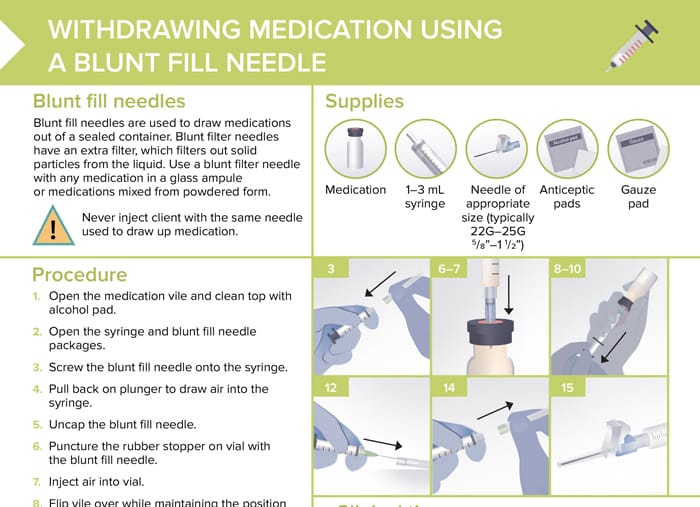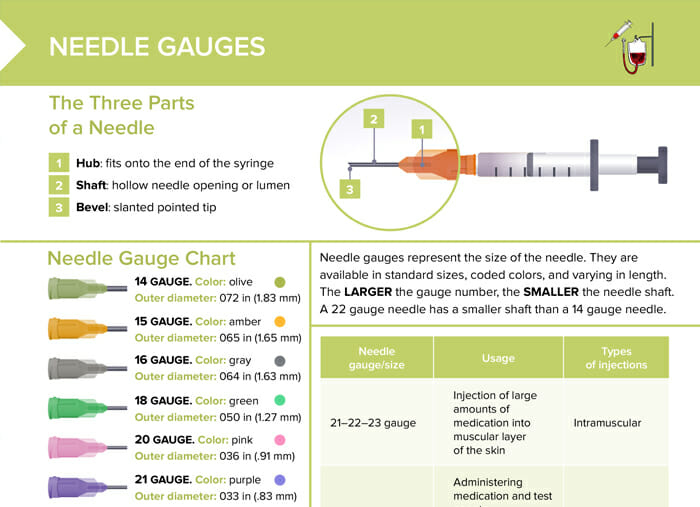What are the parts of a needle?
A hypodermic needle, the type commonly used in healthcare, is made up of several key parts:
- Hub: This is the part of the needle that attaches to the syringe. The hub is typically made of plastic and is designed to fit securely onto the end of the syringe.
- Shaft: This is the long, slender part of the needle that is inserted into the patient’s body. The shaft is hollow so that fluid can pass through it. It’s made of stainless steel.
- Bevel: This is the slanted tip of the needle that makes skin penetration easier. The length and angle of the bevel can vary depending on the specific type of needle.
What are needle gauges and how do they work?
Needle gauges represent the size of the needle and are available in standard sizes, coded colors, and varying lengths. The gauge of the needle is usually printed on the needle’s packaging or the needle itself. The larger the gauge number, the smaller the needle shaft.
Which color corresponds to which needle gauge?
The color of a needle is a coding system used to easily identify the gauge, or thickness, of the needle. This color coding varies by manufacturer, so make sure to double-check. Here are some common colors and their corresponding gauges:
- Amber: 15 gauge
- Orange: 23 gauge
- Purple: 21 gauge
- Pink: 20 gauge
- Grey: 16 gauge
- Blue: 22 gauge
How do I verify gauge and needle length before use?
The selection of a particular needle for a specific application depends on factors such as the route of administration, the volume and viscosity of medication, and the size and condition of the client. Always refer to the specific guidelines and double-check this information about needle gauge and length on the needle’s packaging (or the needle itself) before using the needle.
When do I use thinner vs thicker needles?
Thinner needles (with higher gauge numbers) are used when the medication is less viscous and the procedure is less invasive, like a subcutaneous injection. Thicker needles (with lower gauge numbers) are used for more viscous medications and more invasive procedures, like an intramuscular injection or drawing blood.
What are some common types of injections and which needles should I use for them?
- Intramuscular injections: 21–22–23 gauge (injection of large amounts of medication)
- Intradermal injections: 24–27 or 29 gauge (administering medication and test agents)
- Subcutaneous injections:
- Insulin syringes are 31–25 gauge and are marked in units.
- Tuberculin syringes hold 1 mL and are marked as hundreds of a milliliter.
- Administering medications withdrawn from glass ampule: filter needle
Related videos
What is a filter needle and when should I use it?
A filter needle is a type of needle with a small glass filtering device designed to remove any small particles or impurities from the substance being drawn up into the syringe. They are primarily used for:
- Drawing up medication from a glass ampule (to ensure no small shards of glass are drawn up into the syringe)
- When preparing certain types of medications (for filtering out impurities or particulates)
How do I care for a client with a phobia of needles?
For clients who have a fear of needles, known as trypanophobia, use these strategies:
- Acknowledge the client’s fear and provide a caring attitude.
- Explain the procedure in simple terms. Describe why the injection is necessary and what can be expected, but avoid going into graphic detail which may increase their anxiety.
- Provide distraction.
- Deep breathing exercises or other relaxation techniques can help calm the client.
- Minimize pain by using smaller needles if possible; potentially use a local anesthetic cream or spray to numb the skin before injection.
- Let the client sit or lie down if prone to fainting.
Remember, it’s important to be patient and supportive when providing an injection to someone who is already nervous.

